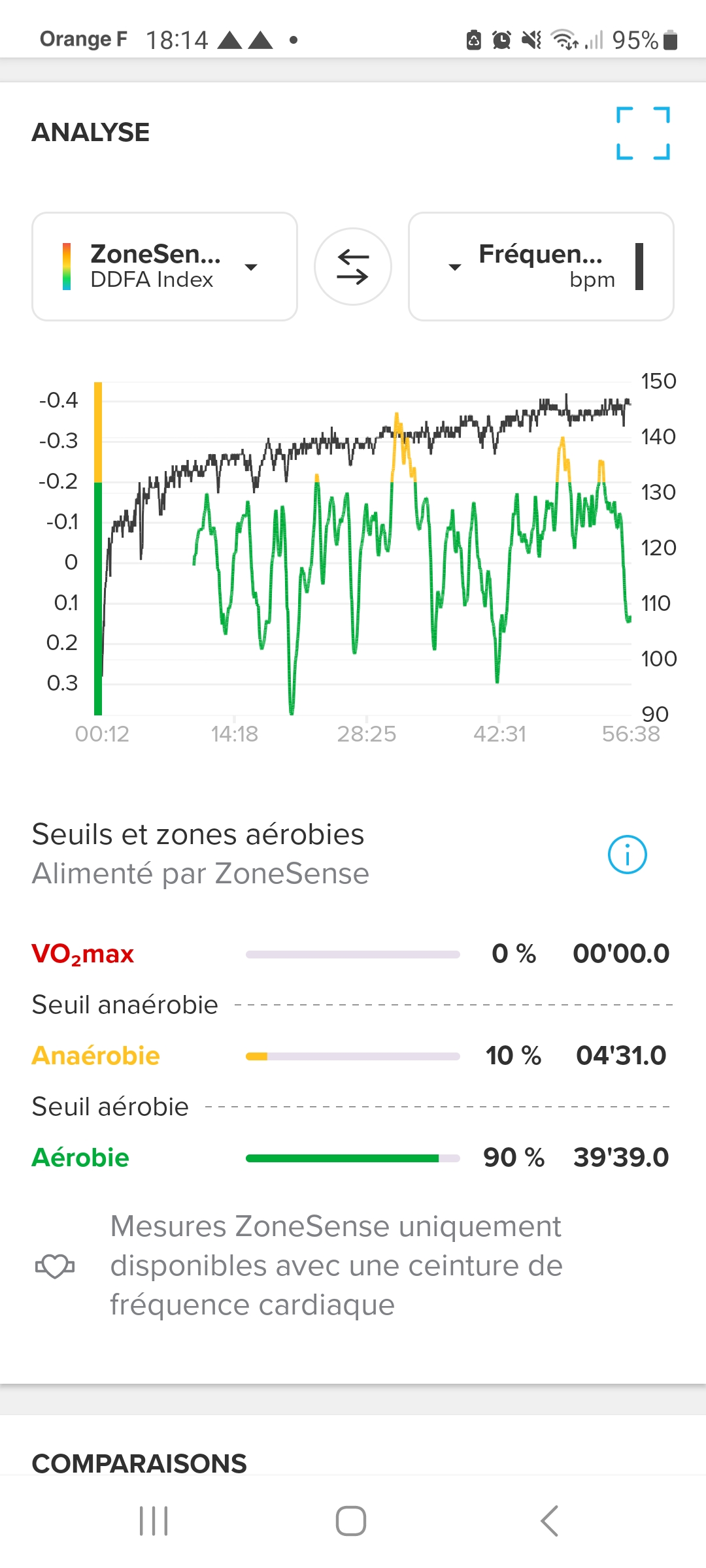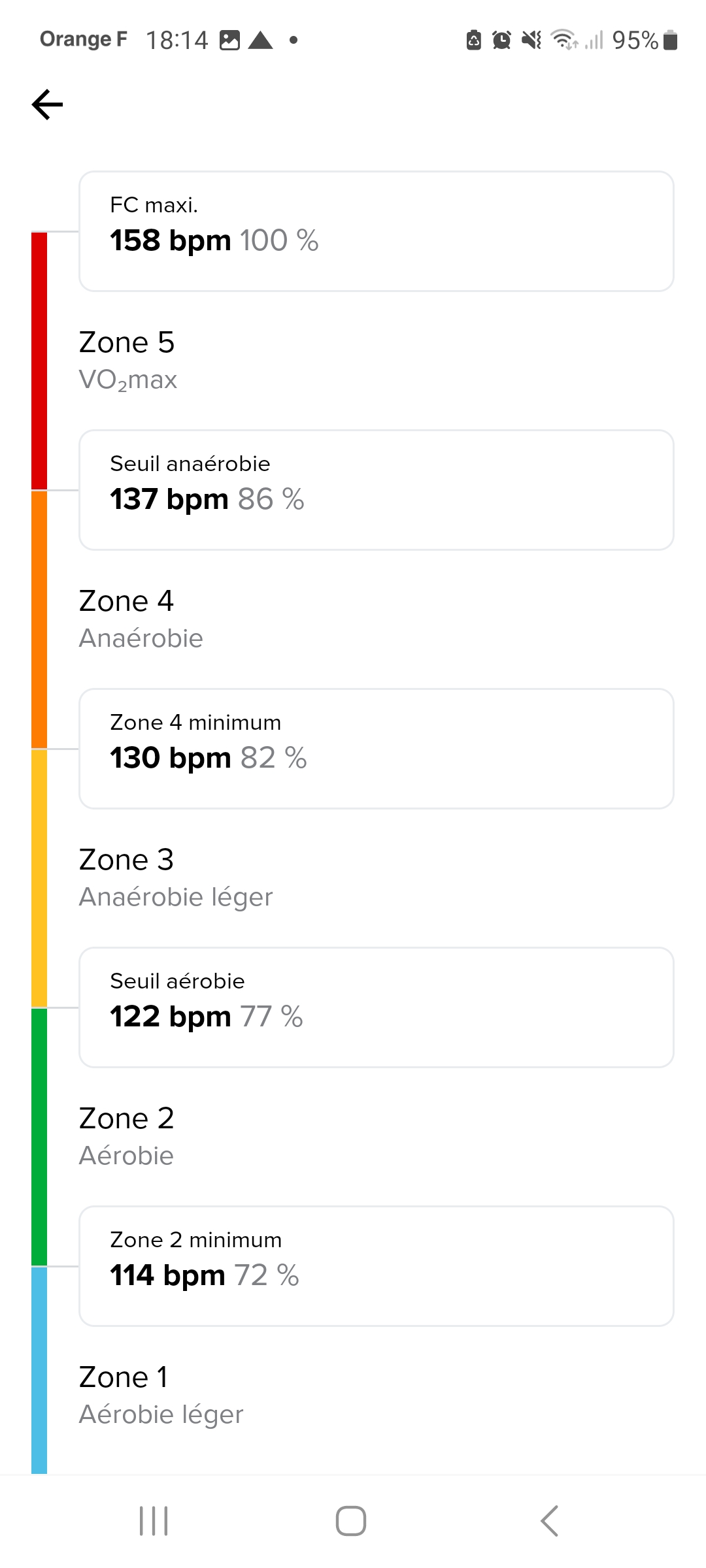Zonesense difficult to understand
-
@luke55 those HR values for the zones look very low, how did you find your zones? Being fully aerobic under 130 BPM is quite valid.
-
@luke55 As stated before, your zones are incorrect. How did you determine your HR zones? For your workout, AT threshold is somewhere between 130 and 140, you were at no time in VO2Max. My AT is 142 and LT 163. My VO2M from the watch is 48, test is 55. Below is a run yesterday with Zonesense. BTW I am 67. You can see my AT from Zonesene in numbers is 140 but from the graph that is about where I enter anaerobic zone.
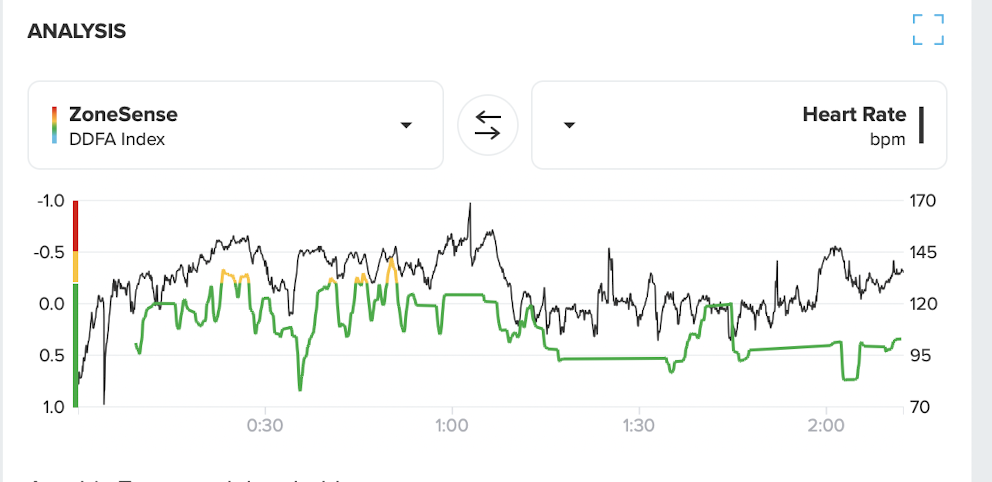
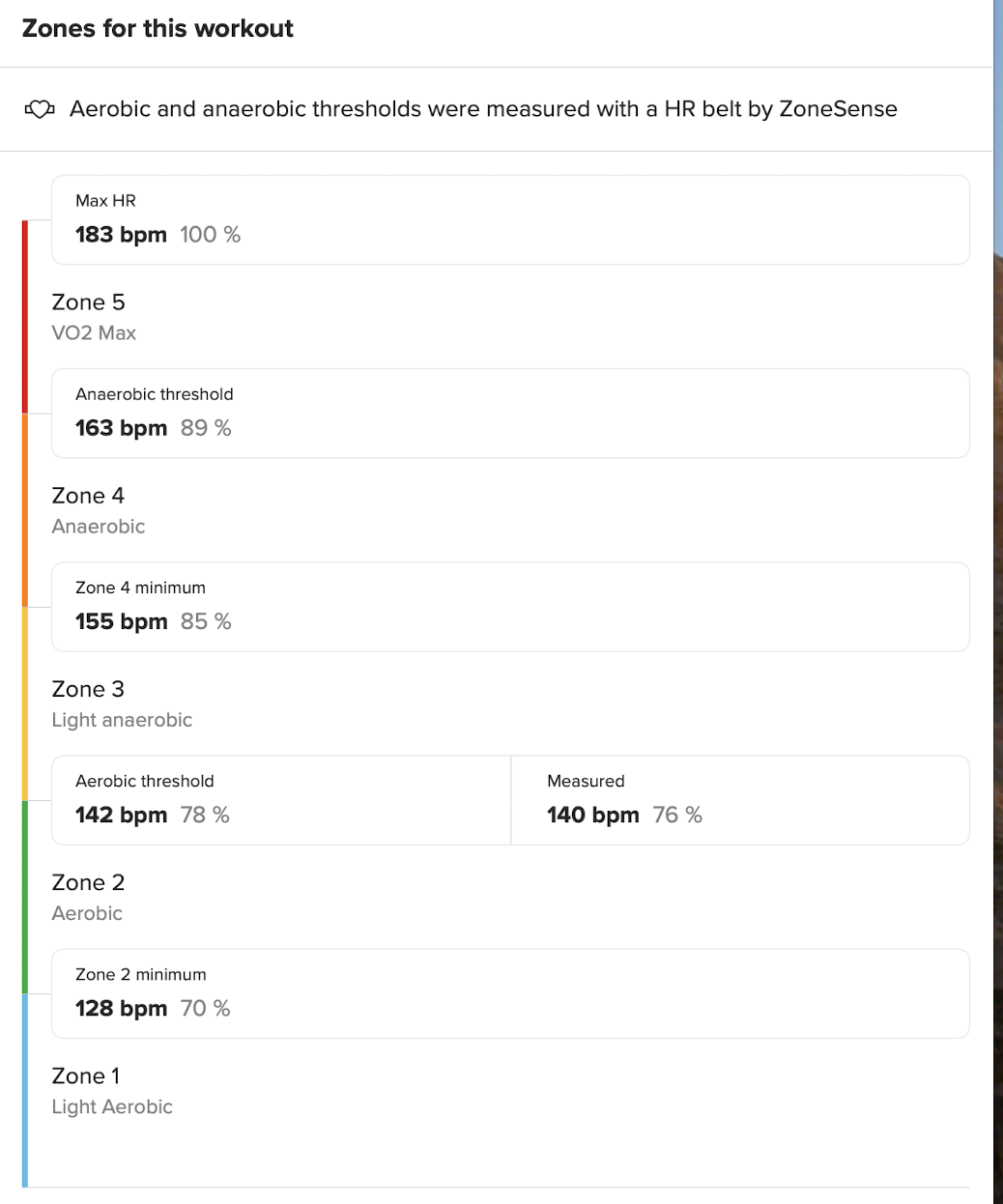
-
@Brad_Olwin
I let the default values for all sports in the watch settings.
Given that my max HR value is 158 (I am 69), these zone values did not look abnormal to me, and they are coherent with how I feel during activities, for example, above 130, I am hardly able to speak fluently.BTW, in a previous run, in the zone screen, there was one value (125 in front of 122) in the 2nd column.
But in the last run , no value at all, not sûre what that mean -
@luke55 I have nearly the same situation. I pushed into VO2MAX ( based on heart rate and personal feeling) and Zonesense gave me a little bit anaerobic and no VO2MAX. Maybe it takes more workouts to calibrate, I only did two with HR Belt
-
@luke55 said in Zonesense difficult to understand:
@Brad_Olwin
I let the default values for all sports in the watch settings.
Given that my max HR value is 158 (I am 69), these zone values did not look abnormal to me, and they are coherent with how I feel during activities, for example, above 130, I am hardly able to speak fluently.BTW, in a previous run, in the zone screen, there was one value (125 in front of 122) in the 2nd column.
But in the last run , no value at all, not sûre what that meanOK, it will vary depending on the exercise and day. If sufficient data are present you will get a value, for example my Zonesense AT has varied from 130 or below to 148. That reflects how I am feeling that day based on stress or prior workouts with AT getting lower when you are fatigued. This is exactly the benefit of ZoneSense. So, you did not have a suggestion in your last workout. It appeared mostly high zone 2 with a bit of anaerobic so should have been moderate and not easy. I am solely using Zonesense now for my training and ignoring HR.
-
@VoiGAS Or you did not spend enough time near or above VO2M, which is hard to do. ZoneSense is not good for short ≤3 min intervals. I would use Power for those.
-
Your max HR is quite high, how did you determine it ?
For me, I used the formula 220 minus age, and increased it a bit, which gave me 158.
Zone values computed by the watch derived from this value, this why you find them so low.Given the sensations I have at 150 bpm, I can’t imagine trying to push higher, so a max HR of 158 seems reasonable for me.
For the moment, I just did two run with zonesense, first was very relax, 17Km in 2 hours, second was much more intensive, 10Km in 56mn.
Definitely, I did not have similar sensations , 2nd was much more difficult, but zonesense reports almost the same result, aerobic in 97% for the first, and 89% for the 2nd, which I find hard to trust! -
@luke55 I did two mountain bike rides (Sunday and Monday) of similar distance but of different difficulty.
Sunday was some punchy climbs which will spike my heart rate, Monday was mostly flat gravel.
Sunday
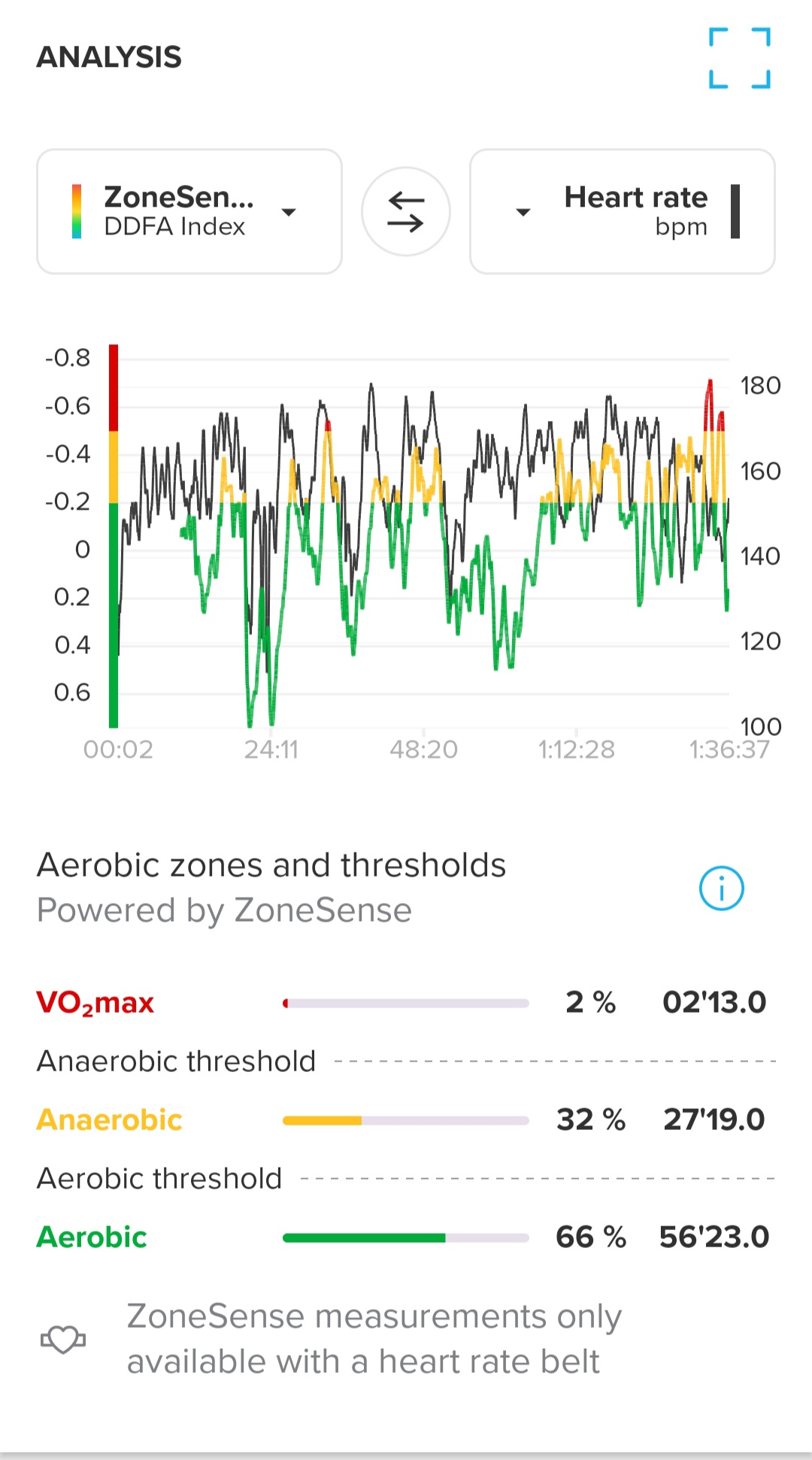
Monday
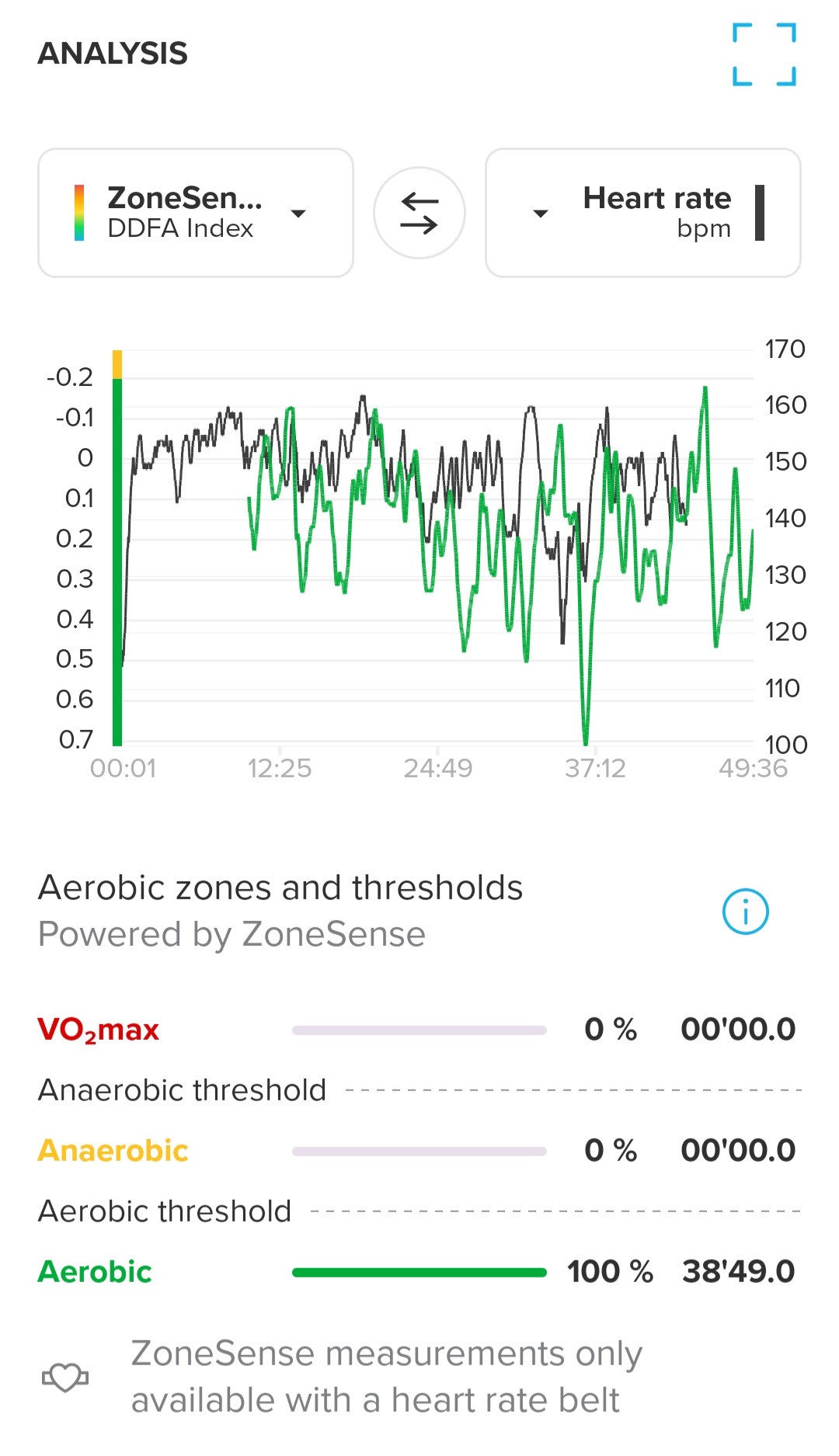
You can see that Sunday I was in anaerobic more than I was compared to Monday. That seems to correlate to the type of riding I was doing, and how winded I was.
-
@luke55 said in Zonesense difficult to understand:
Your max HR is quite high, how did you determine it ?
For me, I used the formula 220 minus age, and increased it a bit, which gave me 158.
Zone values computed by the watch derived from this value, this why you find them so low.Given the sensations I have at 150 bpm, I can’t imagine trying to push higher, so a max HR of 158 seems reasonable for me.
For the moment, I just did two run with zonesense, first was very relax, 17Km in 2 hours, second was much more intensive, 10Km in 56mn.
Definitely, I did not have similar sensations , 2nd was much more difficult, but zonesense reports almost the same result, aerobic in 97% for the first, and 89% for the 2nd, which I find hard to trust!You can try this to define HR zones:
https://moncoachdetriathlon.com/ressources-gratuites/calculateur-frequence-cardiaque/
Just put your email and you will be able dowload an Excel file and pdf file to compute your HR zones.
-
@luke55 said in Zonesense difficult to understand:
Your max HR is quite high, how did you determine it ?
For me, I used the formula 220 minus age, and increased it a bit, which gave me 158.
Zone values computed by the watch derived from this value, this why you find them so low.Given the sensations I have at 150 bpm, I can’t imagine trying to push higher, so a max HR of 158 seems reasonable for me.
For the moment, I just did two run with zonesense, first was very relax, 17Km in 2 hours, second was much more intensive, 10Km in 56mn.
Definitely, I did not have similar sensations , 2nd was much more difficult, but zonesense reports almost the same result, aerobic in 97% for the first, and 89% for the 2nd, which I find hard to trust!My max is set 3-5 bpm higher than the highest HR I had during the prior year. Since my late 30’s and early 40’s my Max has dropped from the low to mid 190’s. I do not know what your baseline fitness is. I have been training and racing ultras for the last 13 years.
-
Quite strange for me also:
According to publication on facebook:Suunto ZoneSense
🟢 Aerobic (green) – covering Z1–Z2
🟡 Anaerobic (yellow) – Z3–Z4
 VO2max (red) – everything beyond anaerobic threshold (Z5).
VO2max (red) – everything beyond anaerobic threshold (Z5).For me SuuntoSens mesured:
151bpm for VO2max (provided by suuntosens)
140bpm for z3-24 (anaerobic) (provided by suuntosens)But 170bpm during 13 minutes are considered in z3-z4 on SuuntoSens graph.
Over 140 is yellow : ok
But over 151 is not red: ko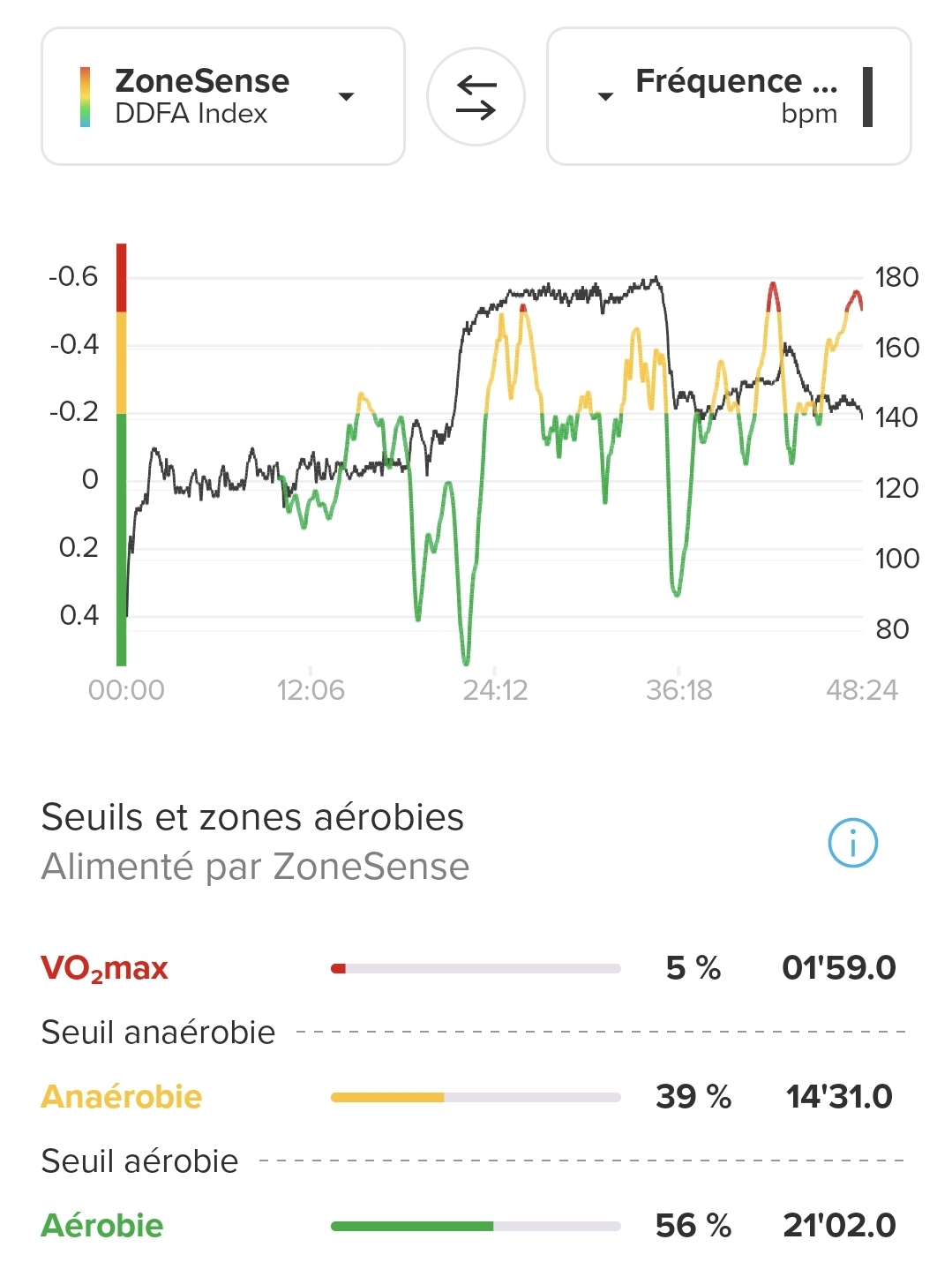
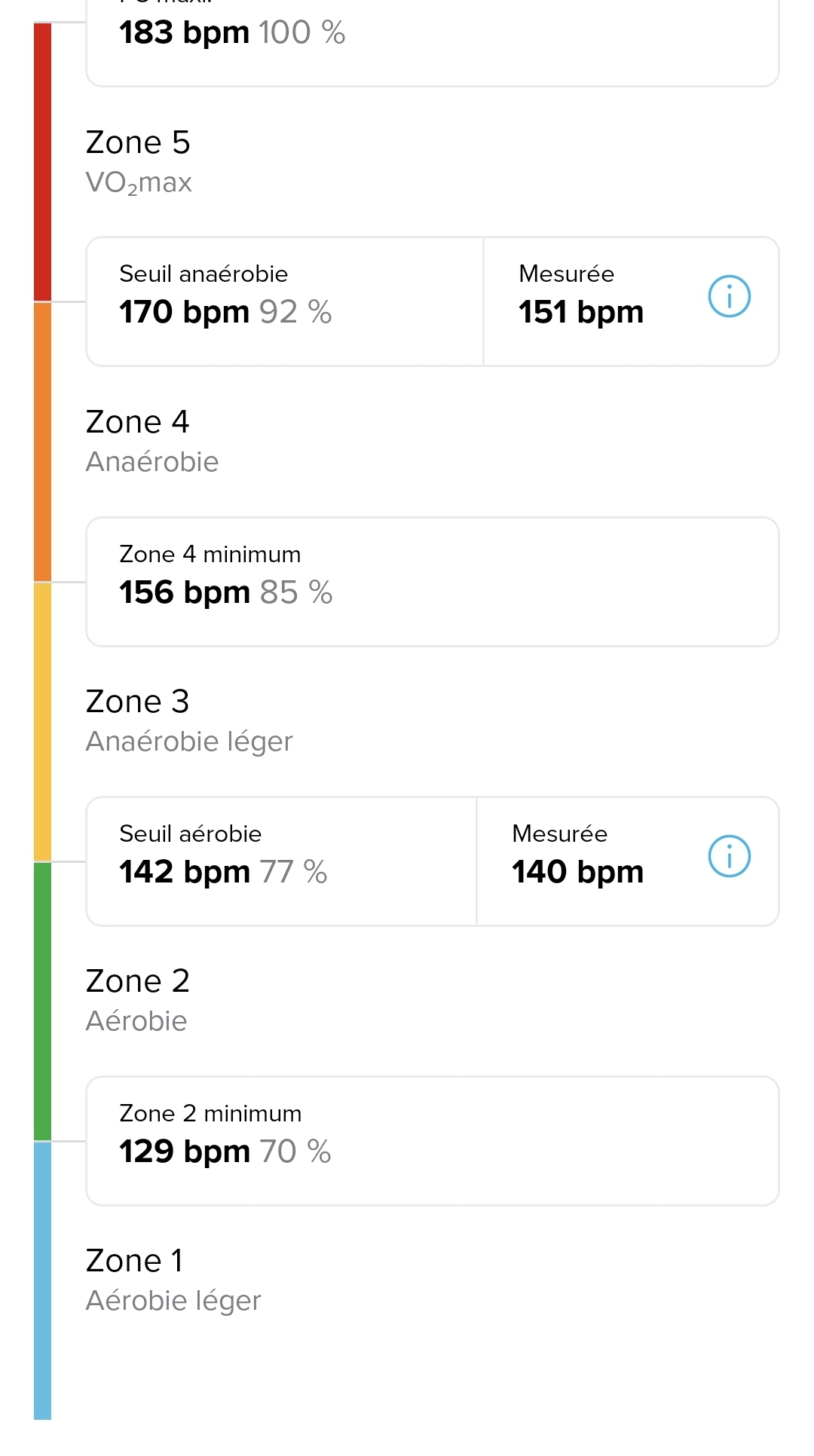
-
@Antoine Looks like Zonesense just takes the HR when entering a zone. In your case the two peaks were when your heartrate was rather low (so not really in sync).
If that really is the way it works, then its rather useless because it will be wrong due to lag or other effects.
For me Zonesense looks more like a Proove of Concept than an actual working feature… -
As far I understand, zonesense is based on HR variability between beats and and this can only be measured with a chest HR sensor (it measures milliseconds differences between beats).
According to Suunto/MoniCardi this variability correlates with the lactate concentration in the blood, so the DDFA index is a indirect measure of lactate.If you look at the @Antoine graph above you can see that between 36’ and 48’ HR goes down but zonesense starts to show red peaks of VO2 max. This is because between 20’ and 36’ there was an intense activity and lactate started to accumulate rapidly.
Another example is in @Todd-Danielczyk graph, look at the end, HR goes down but zonesense shows that you are in VO2max, lactate is high and certainly Todd was exhausted at the end.
I have installed zonesense in my SR watch and I think this is a valuable tool but we need to get used to it.
-
@alebalbis Spot on assessment of how Zonesense can be used.
*also you are right, I was exhausted as I recovered from that one
-
@VoiGAS said in Zonesense difficult to understand:
@Antoine Looks like Zonesense just takes the HR when entering a zone. In your case the two peaks were when your heartrate was rather low (so not really in sync).
If that really is the way it works, then its rather useless because it will be wrong due to lag or other effects.
For me Zonesense looks more like a Proove of Concept than an actual working feature…That is not how ZoneSense works. Have you watched the video? Have you read the peer-reviewed manuscripts published in scientific journals? Have you read the white paper? Please stop speculating on what you think is happening. Perhaps educate yourself instead of making statements that are completely incorrect. I have replied to you many times stating this is not a measure of HR, so have others. It is not meant to follow HR nor is the measurement based on HR. It is based on relationships between IBI and in this manuscript, has been tested far more scientifically than anyone on this forum including me is likely to do. You refuse to acknowledge this. I am fine with you being skeptical of using it but understand how the feature works prior to continuing to assume it is synced to HR!
Kanniainen et al. - 2023 - Estimation of physiological exercise thresholds based on dynamical correlation properties of heart r.pdf -
Hi, I started using the ZS some months ago and I quite intrigued by this new kind of analysis of the HR data. However, I find difficult to understand the results I get. The following graphs refer to the cardio activities I usually performed at the gym: I wear the Suunto smart HR belt at home and walked to the gym and back, so the “real” activity is the central part where the HR goes up. I wonder why in my case the ZS seems to be nearly anticorrelated to the HR data, going usually down during the more intense part of the recorded activity. Maybe the initial part il too long or too easy to correctly trigger the ZS detection? Any hint?
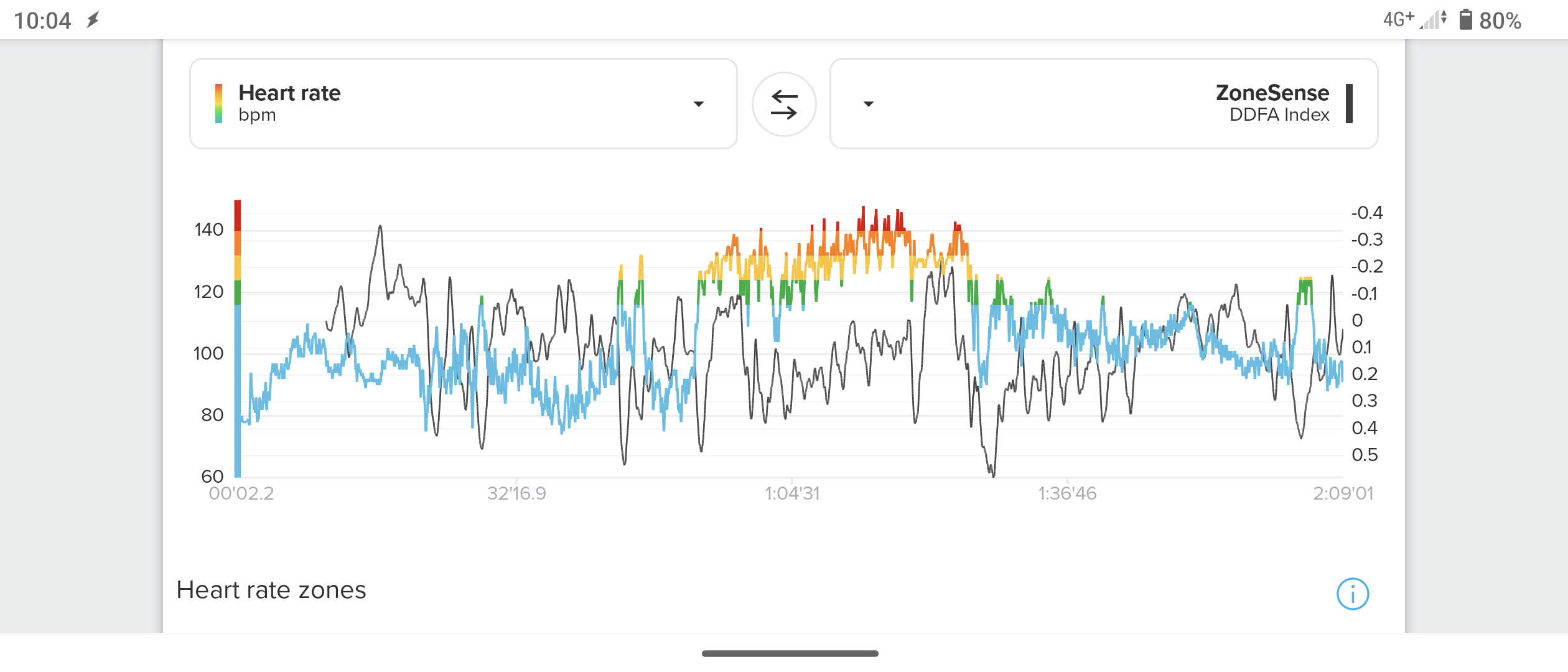

At least, over 16 similar activities, I got 3 times consistent determinations of the Aerobic Threshold (133, 136 and 137 bpm)
-
@Brad_Olwin
How did you determine your max HR, it seems quite high at 67 !!
For me, I just applied the formula 220 minus age, and increased a bit the result, and all zone values computed by the watch are based on that, this is why they seem so low. -
@luke55 sorry, wrong post, cant delete
-
@luke55 said in Zonesense difficult to understand:
@Brad_Olwin
How did you determine your max HR, it seems quite high at 67 !!
For me, I just applied the formula 220 minus age, and increased a bit the result, and all zone values computed by the watch are based on that, this is why they seem so low.I add a few bpm to my max for the last few months. Last set of uphill intervals I did the max was 178 bpm three days ago. Been routinely hitting 177 on these so 180-183 is probably about right. That is how I determine my max.
BTW I am 68 now.
Using age calculations is a bad idea IMHO, they are usually way, way off.
-
Out of coincidence, does Zonesense only work for long, steady efforts? I do a lot of HIIT and Hyrox training, and I find that my feelings and regular BPM correlate, but Zonesense will show me as working mainly aerobically.
